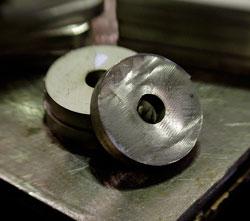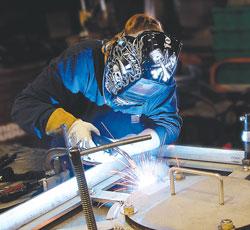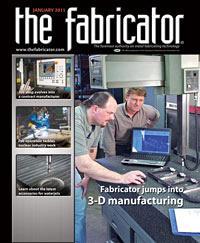Senior Editor
- FMA
- The Fabricator
- FABTECH
- Canadian Metalworking
Categories
- Additive Manufacturing
- Aluminum Welding
- Arc Welding
- Assembly and Joining
- Automation and Robotics
- Bending and Forming
- Consumables
- Cutting and Weld Prep
- Electric Vehicles
- En Español
- Finishing
- Hydroforming
- Laser Cutting
- Laser Welding
- Machining
- Manufacturing Software
- Materials Handling
- Metals/Materials
- Oxyfuel Cutting
- Plasma Cutting
- Power Tools
- Punching and Other Holemaking
- Roll Forming
- Safety
- Sawing
- Shearing
- Shop Management
- Testing and Measuring
- Tube and Pipe Fabrication
- Tube and Pipe Production
- Waterjet Cutting
Industry Directory
Webcasts
Podcasts
FAB 40
Advertise
Subscribe
Account Login
Search
Laser cutting thick stainless steel—fast
Shop acquires high cutting power for nuclear industry work
- By Tim Heston
- January 17, 2011
- Article
- Laser Cutting

PCI cut these components for the nuclear industry using a 7-kW CO2 laser cutting center. Photo courtesy of TRUMPF Inc.
The sale of safety products—especially ones designed to prevent unlikely but seriously scary disasters—doesn’t follow economic cycles, and one custom metal fabricator in Kansas is proof of that.
That fabricator is part of one of the largest specialty contractors in the country. With more than 6,000 people on the payroll, Performance Contracting Group (PCG) generated $923 million in sales in 2009. PCG’s largest subsidiary is Performance Contracting Inc. (PCI). Within a PCI division called Engineered Systems Group (ESG) is a metal fabrication operation that employs about 30 people who work in a 15,000-square-foot facility in Lenexa, Kan.
ESG remained a significant profit center for the past five years thanks in large part to one safety product designed to prevent those unlikely disasters.
Keep the Water Flowing
The product, fabricated for the nuclear industry, is called the Sure-Flow® Strainer (see Figures 1 and 2), an assembly designed to prevent debris from spreading into the reactor after a pipe burst or similar event, what nuclear engineers call a loss of coolant accident, or LOCA.
LOCAs, however unlikely, are very serious. If a coolant pipe bursts, emergency pumps spring into action, sending water back into the reactor. But debris from the accident could damage or break the pump, or even block the flow of cooling water back into the reactor—and a nuclear reactor operating without coolant has disastrous consequences.
This is why ESG makes those strainers. When U.S. nuclear plants began upgrading several years ago, ESG won its first batch of strainer contracts. Designed to have maximum surface area in a very small space, each strainer consists of thousands of perforated stainless steel plate sections. The assembly filters debris so that the pumps never become clogged and the flow of water back to the reactor is never blocked.
When the company won its first strainer contract, it bought its first laser cutting machine, a 4-kW system that cuts through 0.5-in.-thick stainless steel. It worked well for the job, but soon another contract would put the company’s fabrication capabilities to the test—and it started with a call from Japan.
One of the country’s major power industry players, Mitsubishi Heavy Industries (MHI), saw value in ESG’s strainers. So about four years ago the company called on the Kansas shop for help. MHI was under contract with all 24 of Japan’s PWR, or pressurized water reactor, nuclear power plants, which needed similar safety upgrades as plants in the U.S.
To meet the new demand, ESG shifted into high gear, and the backlog kept the floor busy throughout the Great Recession. “We experienced no downturn in 2009,” said Jim Bleigh, Engineered Systems manager. “We had as many people as we ever had that year.”
As Bleigh explained, it didn’t matter that the strainers would need to be assembled at ESG to ensure quality, disassembled, and then shipped across the Pacific. The fact that MHI contracted with a U.S. firm shows how much experience counts in the nuclear sector. Quality and safety reign supreme, and ESG happened to have a patented solution that met the industry’s stringent requirements.

Figure 1: These strainers for the nuclear industry, fabricated by Performance Contracting Inc. / Engineered Systems Group’s metal fabrication facility, consist of thousands of perforated stainless steel plates that are supported by 1-in.-thick stainless steel platforms. Photo courtesy of PCI.
High-power Cutting
The Japanese plants require strainers with up to 5,000 components. They consist of pipes rolled and seam-welded. Around each pipe are thick plates, stacked vertically 1 in. apart, fabricated from perforated stainless steel. A large hole in each is cut with a flat teeth pattern, so the plate can mate securely to the central pipe. Add to this the numerous holes required for fasteners, and you end up with a serious amount of laser cutting (see Figure 3).
“Because of the new strainer’s structural and seismic requirements, we had to start designing some of the components with 1-in.-thick stainless steel plate,” Bleigh said. “We knew the prior cutting machine wasn’t capable of doing that, and we didn’t want to farm the work out and lose control of our schedule.”
So the company bought an unusually powerful cutting machine, the TRUMPF TruLaser 5030 New with 7 kW of power. Operators successfully cut through 1-in.-thick stainless steel at up to 14 inches per minute (IPM). The laser also meets the job’s critical tolerance requirements with minimal subsequent deburring.
As Jason Coleman, principal laser operator, explained, cutting such thick plate requires some finesse. The process starts normally, with the operator performing a tape-shot test to ensure optimal beam alignment. Coleman uses a 2.3- or 2.7-mm-diameter nozzle for the 1-in.-thick material, and a 1.7-mm-diameter nozzle for thinner stock (the shop processes a fair amount of 22-gauge stainless, for instance). He primarily cuts with nitrogen, though he uses oxygen for the occasional carbon steel job.
Cutting speed is especially sensitive. If it isn’t set to the sweet spot, dross can result. If the head moves just a hair too quickly, “the metal doesn’t have a chance to blow out completely,” Coleman said, producing significant dross near the cut’s bottom edge. If the laser head moves too slowly, excess molten metal gathers at the bottom of the cut, again producing dross. All this must be balanced with the correct focal length and nozzle.
Searching for Business
The plate-cutting experience may prove valuable in the months ahead as the company undergoes a transition. “We just finished our biggest year ever,” said Bleigh, adding that those strainer contracts kept the shop busy during slow times for PCI’s bread-and-butter business: commercial and industrial construction. The strainer contracts will end soon, though, so shop managers are hunting for new markets to sell the shop’s unusual cutting capacity to.
As part of one of the largest specialty contractors in the country, ESG’s metal shop may have unique opportunities on the horizon. For instance, other PCI branches may provide components for portable houses built with panels consisting of foam interiors and sheet metal exteriors. The buildings would be used for aid camps and similar operations in impoverished areas of the world. The project could involve high volumes, and some components could be cut on the 7-kW laser system.
For other opportunities, managers are again turning to the nuclear field. “Many nuclear facilities are upgrading their plants with an all-metal-type insulation product,” Bleigh explained. “We’re hoping for that business to take off and replace a lot of the strainer work that we’ll be losing, and certainly the laser will be a key piece of equipment for that operation.”
A Business Apart
Bleigh’s group is a unique part of PCI. It’s a metal fabrication job shop that operates as a stand-alone profit center among PCI’s specialty contracting businesses, which provide a variety of commercial and industrial construction services. “What we do is very different from what the entire company does,” Bleigh said, “and it’s been that way since the [metal shop] was launched 25 years ago.”
Still, ESG, like its corporate parent, has deep roots in nuclear power. The fabrication shop initially manufactured the stainless steel jacketing used for one of PCI’s flagship products, NUKON® nuclear containment insulation. The jacketing was cut on a plasma machine, which the company sold after buying its first laser. These days, to minimize deburring and to meet critical tolerances, the shop cuts most part profiles with a laser exclusively. As the shop built up its in-house fabrication capabilities with press brakes, shears, welding, and cutting services, it started to bring in work from customers unassociated with the rest of PCI.

Figure 2: Melanie Marlett welds a strainer component in the metal shop. Photo courtesy of TRUMPF Inc.
Bleigh, who started with the organization 34 years ago and climbed the ranks to oversee various product lines, eventually became the Engineered Systems Group manager. He joined the organization when it was a division of Owens Corning Fiberglas (OCF). In 1987 several managers purchased the division from OCF and, during the ensuing years, grew Performance Contracting Group as a private, employee-owned company. The company, which remains employee-owned, now has more than 50 branch offices across the country.
Bleigh chuckled a bit. “I’ve always said that I was transferred [from Owens Corning] with the assets and liabilities, and I never asked which side of the sheet I was on. I think I’ve been on both sides.
“For most of its existence this branch has been a small contributor,” he continued. “But in the past five to eight years, with our success with the strainer work, we’ve been a significant contributor. It’s been very rewarding for us.”
About the Author

Tim Heston
2135 Point Blvd
Elgin, IL 60123
815-381-1314
Tim Heston, The Fabricator's senior editor, has covered the metal fabrication industry since 1998, starting his career at the American Welding Society's Welding Journal. Since then he has covered the full range of metal fabrication processes, from stamping, bending, and cutting to grinding and polishing. He joined The Fabricator's staff in October 2007.
Related Companies
subscribe now

The Fabricator is North America's leading magazine for the metal forming and fabricating industry. The magazine delivers the news, technical articles, and case histories that enable fabricators to do their jobs more efficiently. The Fabricator has served the industry since 1970.
start your free subscription- Stay connected from anywhere

Easily access valuable industry resources now with full access to the digital edition of The Fabricator.

Easily access valuable industry resources now with full access to the digital edition of The Welder.

Easily access valuable industry resources now with full access to the digital edition of The Tube and Pipe Journal.
- Podcasting
- Podcast:
- The Fabricator Podcast
- Published:
- 04/16/2024
- Running Time:
- 63:29
In this episode of The Fabricator Podcast, Caleb Chamberlain, co-founder and CEO of OSH Cut, discusses his company’s...
- Industry Events
16th Annual Safety Conference
- April 30 - May 1, 2024
- Elgin,
Pipe and Tube Conference
- May 21 - 22, 2024
- Omaha, NE
World-Class Roll Forming Workshop
- June 5 - 6, 2024
- Louisville, KY
Advanced Laser Application Workshop
- June 25 - 27, 2024
- Novi, MI
































